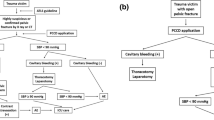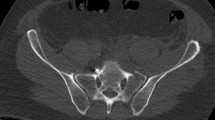Abstract
Purpose
External emergency stabilization (EES) of unstable pelvic fractures reduces haemorrhage and mortality. Available are non-invasive procedures (sheet sling and pelvic binder) and invasive procedures (external fixator and pelvic C-clamp). Nevertheless, there is no recommended standard as to which procedure for EES should be used.
Methods
Prospectively collected data between 2007 and 2016 from the German Pelvic Trauma Registry were used to evaluate 989 patients with in-hospital EES. Besides age, gender and injury severity score (ISS), the fracture classification was evaluated. Furthermore, the frequency of used EES, time to application, their reported efficacy and the frequencies of change to another EES were investigated.
Results
The use of pelvic binders increased up to 40% while all other procedures decreased in frequency over the 10-year period. The ISS was highest in patients treated with a pelvic C-clamp or combination of pelvic C-clamp and external fixator (p < 0.05). Non-invasive stabilization was applied significantly faster than invasive procedures (p < 0.0001). Overall, the reported efficacy was good (at least 70%) for all procedures but with poorest results for the pelvic binder and best for the external fixator (p < 0.00001). Most change to another EES was found for the sheet sling and pelvic binder.
Conclusion
In case of suspected unstable pelvic fracture, an EES should be performed, in case of doubt with a non-invasive EES until imaging and final diagnosis. Which method should be used depends on the individual situation and the available information about the overall injury pattern. Invasive EES are preferable for treatment according to Damage Control Orthopaedics.





Similar content being viewed by others
References
Burkhardt M, Holstein JH, Moersdorf P, Kristen A, Lefering R, Pohlemann T, Pizanis A. Proper coding of the Abbreviated Injury Scale: can clinical parameters help as surrogates in estimating blood loss? Eur J Trauma Emerg Surg. 2014;40:473–9.
Giannoudis PV, Grotz MRW, Tzioupis C, Dinopoulos H, Wells GE, Bouamra O, Lecky F. Prevalence of pelvic fractures, associated injuries, and mortality: the United Kingdom perspective. J Trauma. 2007;63:875–83.
Pohlemann T, Tscherne H, Baumgärtel F, Egbers HJ, Euler E, Maurer F, et al. Beckenverletzungen: Epidemiologie, Therapie und Langzeitverlauf. Ubersicht über die multizentrische Studie der Arbeitsgruppe Becken. Unfallchirurg. 1996;99:160–7.
Holstein JH, Culemann U, Pohlemann T. What are predictors of mortality in patients with pelvic fractures? Clin Orthop Relat Res. 2012;470:2090–7.
Deutsche Gesellschaft für Unfallchirurgie, Deutsche Gesellschaft für Allgemein- und Viszeralchirurgie, Deutsche Gesellschaft für Anästhesiologie und Intensivmedizin et al. S3-Leitlinie Polytrauma/Schwerverletzten-Behandlung:012/019. https://www.awmf.org/leitlinien/detail/ll/012-019.html. Accessed 25 Aug 2017.
Ertel W, Keel M, Eid K, Platz A, Trentz O. Control of severe hemorrhage using C-clamp and pelvic packing in multiply injured patients with pelvic ring disruption. J Orthop Trauma. 2001;15:468–74.
Burkhardt M, Nienaber U, Pizanis A, Maegele M, Culemann U, Bouillon B, et al. Acute management and outcome of multiple trauma patients with pelvic disruptions. Crit Care. 2012;16:R163. https://doi.org/10.1186/cc11487.
Rommens PM, Hofmann A, Hessmann MH. Management of acute hemorrhage in pelvic trauma: an overview. Eur J Trauma Emerg Surg. 2010;36:91–9.
DeAngelis NA, Wixted JJ, Drew J, Eskander MS, Eskander JP, French BG. Use of the trauma pelvic orthotic device (T-POD) for provisional stabilisation of anterior-posterior compression type pelvic fractures: a cadaveric study. Injury. 2008;39:903–6.
Routt MLC, Falicov A, Woodhouse E, Schildhauer TA. Circumferential pelvic antishock sheeting: a temporary resuscitation aid. J Orthop Trauma. 2006;20:S3–6.
Tiemann AH, Böhme J, Josten C. Anwendung der Beckenzwinge beim polytraumatisierten Patienten mit instabilem Becken. Modifizierte Technik–Gefahren–Probleme. Orthopade. 2006;35:1225–36.
Schweigkofler U, Wohlrath B, Paffrath T, Flohé S, Wincheringer D, Hoffmann R, Trentzsch H. “Clear-the-Pelvis-Algorithmus”: handlungsempfehlung zur Freigabe des Beckens nach nicht invasiver Stabilisierung mittels Beckengurt im Rahmen der Schockraumversorgung. Z Orthop Unfall. 2016;154:470–6.
Pohlemann T, Krettek C, Hoffmann R, Culemann U, Gänsslen A. Biomechanischer Vergleich verschiedener Notfallstabilisierungsmassnahmen am Beckenring. Unfallchirurg. 1994;97:503–10.
Knops SP, van Lieshout EMM, Spanjersberg WR, Patka P, Schipper IB. Randomised clinical trial comparing pressure characteristics of pelvic circumferential compression devices in healthy volunteers. Injury. 2011;42:1020–6.
Tan ECTH, van Stigt SFL, van Vugt AB. Effect of a new pelvic stabilizer (T-POD®) on reduction of pelvic volume and haemodynamic stability in unstable pelvic fractures. Injury. 2010;41:1239–43.
Pohlemann T, Stengel D, Tosounidis G, Reilmann H, Stuby F, Stöckle U, et al. Survival trends and predictors of mortality in severe pelvic trauma: estimates from the German Pelvic Trauma Registry Initiative. Injury. 2011;42:997–1002.
Marsh JL, Slongo TF, Agel J, Broderick JS, Creevey W, DeCoster TA, et al. Fracture and dislocation classification compendium—2007: orthopaedic Trauma Association classification, database and outcomes committee. J Orthop Trauma. 2007;21:S1–133.
Hauschild O, Strohm PC, Culemann U, Pohlemann T, Suedkamp NP, Koestler W, Schmal H. Mortality in patients with pelvic fractures: results from the German pelvic injury register. J Trauma. 2008;64:449–55.
Krieg JC, Mohr M, Ellis TJ, Simpson TS, Madey SM, Bottlang M. Emergent stabilization of pelvic ring injuries by controlled circumferential compression: a clinical trial. J Trauma. 2005;59:659–64.
Croce MA, Magnotti LJ, Savage SA, Wood GW, Fabian TC. Emergent pelvic fixation in patients with exsanguinating pelvic fractures. J Am Coll Surg. 2007;204:935–9 (discussion 940-2).
Ghaemmaghami V, Sperry J, Gunst M, Friese R, Starr A, Frankel H, et al. Effects of early use of external pelvic compression on transfusion requirements and mortality in pelvic fractures. Am J Surg. 2007;194:720–3 (discussion 723).
Tosounidis TI, Giannoudis PV. Pelvic fractures presenting with haemodynamic instability: treatment options and outcomes. Surgeon. 2013;11:344–51.
Mauffrey C, Cuellar DO, Pieracci F, Hak DJ, Hammerberg EM, Stahel PF, et al. Strategies for the management of haemorrhage following pelvic fractures and associated trauma-induced coagulopathy. Bone Joint J. 2014;96(B):1143–54.
Marzi I, Lustenberger T. Management of Bleeding Pelvic Fractures. Scand J Surg. 2014;103:104–11.
Ohmori T, Kitamura T, Nishida T, Matsumoto T, Tokioka T. The impact of external fixation on mortality in patients with an unstable pelvic ring fracture: A propensity-matched cohort study. Bone Jt J. 2018;100(B):233–41.
Kim MJ, Lee JG, Lee SH. Factors predicting the need for hemorrhage control intervention in patients with blunt pelvic trauma: a retrospective study. BMC Surg. 2018;18:101. https://doi.org/10.1186/s12893-018-0438-8.
Rich C, Rayner J, Raukar N. Nondisplaced pubic ramus fracture associated with exsanguination and death. Am J Emerg Med. 2018;36:342.e1–2. https://doi.org/10.1016/j.ajem.2017.10.062.
ten Broek RPG, Bezemer J, Timmer FA, Mollen RMHG, Boekhoudt FD. Massive haemorrhage following minimally displaced pubic ramus fractures. Eur J Trauma Emerg Surg. 2014;40:323–30.
Turgut A, Kalenderer Ö, Akan I, Ilyas G, Kumbaraci M, Karapinar L. Do patients with acute isolated pubic ramus fractures have to be hospitalized? Acta Orthop Belg. 2017;83:574–80.
Shlamovitz GZ, Mower WR, Bergman J, Chuang KR, Crisp J, Hardy D, et al. How (un)useful is the pelvic ring stability examination in diagnosing mechanically unstable pelvic fractures in blunt trauma patients? J Trauma. 2009;66:815–20.
Lee C, Sciadini M. The use of external fixation for the management of the unstable anterior pelvic ring. J Orthop Trauma. 2018;32(Suppl 6):S14–7.
Vécsei V, Negrin LL, Hajdu S. Today’s role of external fixation in unstable and complex pelvic fractures. Eur J Trauma Emerg Surg. 2010;36:100–6.
Hsu S-D, Chen C-J, Chou Y-C, Wang S-H, Chan D-C. Effect of early pelvic binder use in the emergency management of suspected Pelvic Trauma: a retrospective cohort study. Int J Environ Res Public Health 2017. https://doi.org/10.3390/ijerph14101217.
Bonner TJ, Eardley WGP, Newell N, Masouros S, Matthews JJ, Gibb I, Clasper JC. Accurate placement of a pelvic binder improves reduction of unstable fractures of the pelvic ring. J Bone Joint Surg Br. 2011;93:1524–8.
Jain S, Bleibleh S, Marciniak J, Pace A. A national survey of United Kingdom trauma units on the use of pelvic binders. Int Orthop. 2013;37:1335–9.
Fleiter N, Reimertz C, Lustenberger T, Schweigkofler U, Marzi I, Hoffmann R, Walcher F. Bedeutung der korrekten Positionierung eines Beckengurts zur temporären Stabilisierung von Beckenringverletzungen. Z Orthop Unfall. 2012;150:627–9.
Pizanis A, Pohlemann T, Burkhardt M, Aghayev E, Holstein JH. Emergency stabilization of the pelvic ring: clinical comparison between three different techniques. Injury. 2013;44:1760–4.
Lustenberger T, Meier C, Benninger E, Lenzlinger PM, Keel MJB. C-clamp and pelvic packing for control of hemorrhage in patients with pelvic ring disruption. J Emerg Trauma Shock. 2011;4:477–82.
Giannoudis PV, Pape HC. Damage control orthopaedics in unstable pelvic ring injuries. Injury. 2004;35:671–7.
Ondruschka B, Baier C, Dreßler J, Höch A, Bernhard M, Kleber C, Buschmann C. Additive notärztliche Maßnahmen beim traumaassoziierten Herz-Kreislauf-Stillstand. Anaesthesist. 2017;66:924–35.
Author information
Authors and Affiliations
Consortia
Corresponding author
Ethics declarations
Conflict of interest
All the authors declare that they have no conflict of interest.
Electronic supplementary material
Below is the link to the electronic supplementary material.
Rights and permissions
About this article
Cite this article
Höch, A., Zeidler, S., Pieroh, P. et al. Trends and efficacy of external emergency stabilization of pelvic ring fractures: results from the German Pelvic Trauma Registry. Eur J Trauma Emerg Surg 47, 523–531 (2021). https://doi.org/10.1007/s00068-019-01155-9
Received:
Accepted:
Published:
Issue Date:
DOI: https://doi.org/10.1007/s00068-019-01155-9




